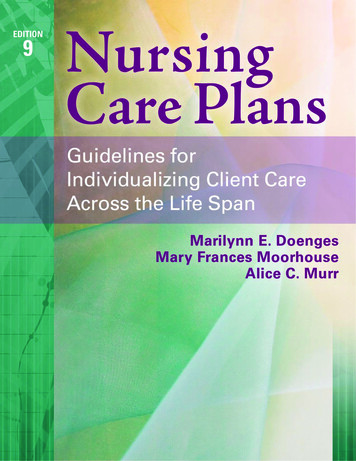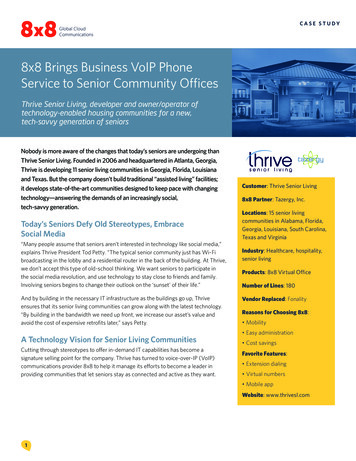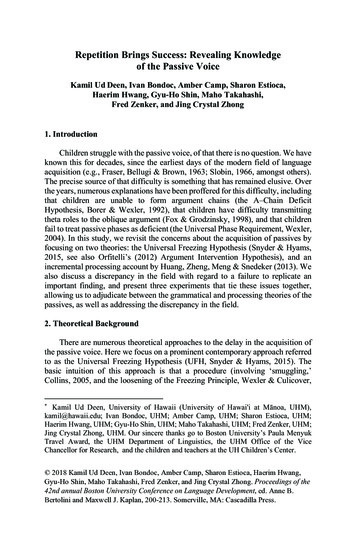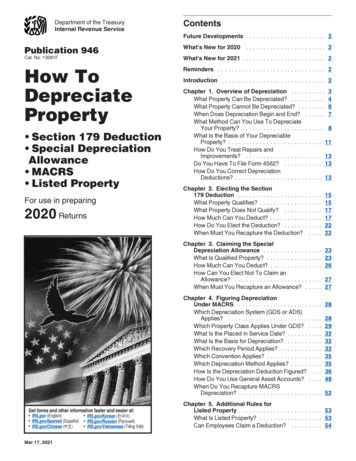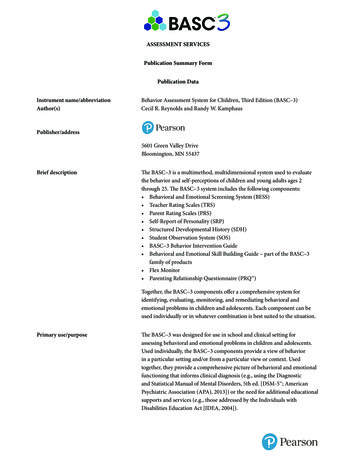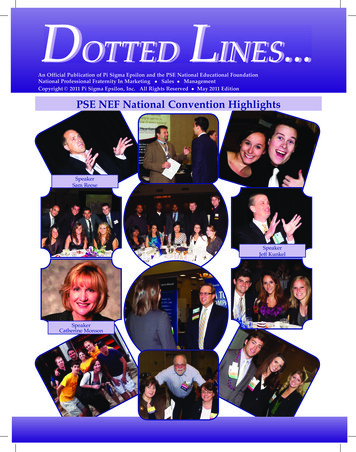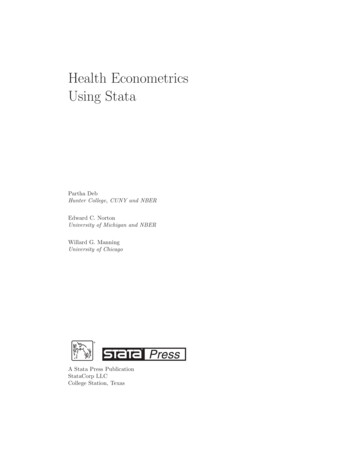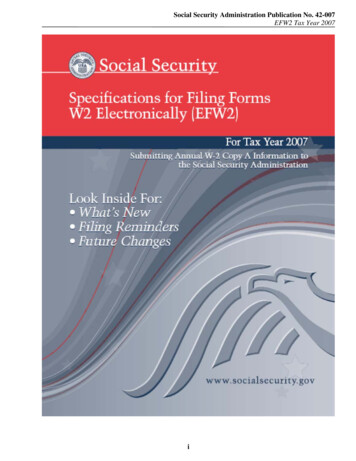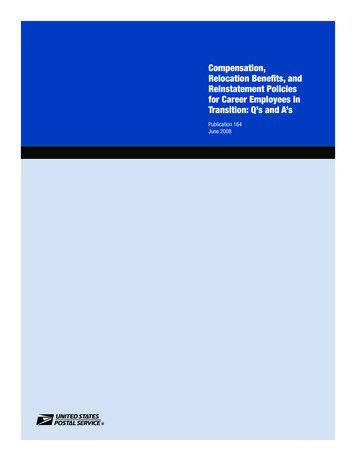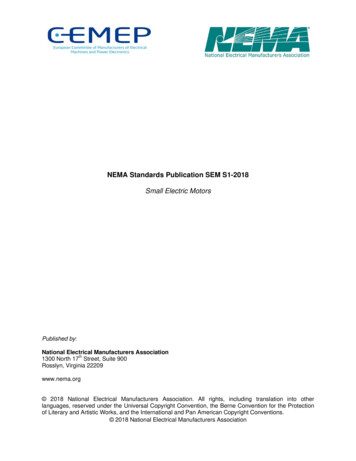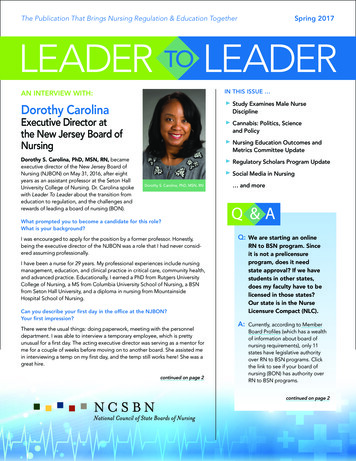
Transcription
Spring 2017The Publication That Brings Nursing Regulation & Education TogetherAN INTERVIEW WITH:IN THIS ISSUE Dorothy Carolina Study Examines Male NurseDisciplineExecutive Director atthe New Jersey Board ofNursingDorothy S. Carolina, PhD, MSN, RN, becameexecutive director of the New Jersey Board ofNursing (NJBON) on May 31, 2016, after eightyears as an assistant professor at the Seton HallUniversity College of Nursing. Dr. Carolina spokewith Leader To Leader about the transition fromeducation to regulation, and the challenges andrewards of leading a board of nursing (BON). Cannabis: Politics, Scienceand Policy Nursing Education Outcomes andMetrics Committee Update Regulatory Scholars Program Update Social Media in NursingDorothy S. Carolina, PhD, MSN, RN and moreWhat prompted you to become a candidate for this role?What is your background?I was encouraged to apply for the position by a former professor. Honestly,being the executive director of the NJBON was a role that I had never considered assuming professionally.Q: We are starting an onlineRN to BSN program. Sinceit is not a prelicensureprogram, does it needstate approval? If we havestudents in other states,does my faculty have to belicensed in those states?Our state is in the NurseLicensure Compact (NLC).I have been a nurse for 29 years. My professional experiences include nursingmanagement, education, and clinical practice in critical care, community health,and advanced practice. Educationally, I earned a PhD from Rutgers UniversityCollege of Nursing, a MS from Columbia University School of Nursing, a BSNfrom Seton Hall University, and a diploma in nursing from MountainsideHospital School of Nursing.Can you describe your first day in the office at the NJBON?Your first impression?There were the usual things: doing paperwork, meeting with the personneldepartment. I was able to interview a temporary employee, which is prettyunusual for a first day. The acting executive director was serving as a mentor forme for a couple of weeks before moving on to another board. She assisted mein interviewing a temp on my first day, and the temp still works here! She was agreat hire.continued on page 2A:Currently, according to MemberBoard Profiles (which has a wealthof information about board ofnursing requirements), only 11states have legislative authorityover RN to BSN programs. Clickthe link to see if your board ofnursing (BON) has authority overRN to BSN programs.continued on page 2
Dorothy Carolina continued from page 1What is a typical day like in the office of the NJBON?“The staff are greatpeople who workhard, so I do a lot ofmentoring andcoaching in an effortto maximize theirpotential.”There really isn’t a typical day as an executive director of a BON. Generally, my dayencompasses meetings, telephone conferences, answering emails, troubleshooting withstaff, professional practice questions and staff mentoring. In the past, the NJ BON had alot more professional staff. Over the years, as the RN professional staff left and weren’treplaced, the expectation remained for the staff to be knowledgeable, think critically anduse good judgment. The staff are great people who work hard, so I do a lot of mentoringand coaching in an effort to maximize their potential.What are some other unique challenges the NJ BON faces?Having limited resources is a major challenge at times. It is difficult to juggle resources,as the NJ BON has nearly 200,000 licensees, which includes regulating certifiedhomemaker-home health aides and training programs. From what I understand, notmany boards of nursing regulate this group of health care providers. Monitoring thoseprograms are a tremendous challenge, as a lot of time is spent on discipline and enforcement and making sure the individuals and home health aide programs are meetingstandards. At times, businesses that train and employ home health aides complain thatit can take a while to process applications, but we need to ensure that whomever we areplacing in these homes are vetted and safe to practice.Has there been anything that came as a surprise in this new role?The work environment in the public sector is dramatically different from that of theprivate sector. The resources are limited and there are many levels involved in thedecision-making process.What are some aspects of your role that you find the most satisfying?Being able to execute decisions made by the board that ultimately protect the public,especially those related to ensuring that schools of nursing are meeting the standards setforth in the regulations. Another satisfying aspect is being able to resolve complaints thatconsumers may have regarding the processing of their licensing application.continued on page 3continued from page 1As for faculty licensure, all BONs require clinical faculty or preceptorsto be licensed in the distant state, since they would be providing, orsupervising the provision of, patient care. By living in a compact state,however, you would have the privilege to practice in any other compactstate as long as you meet the multistate licensure requirements. Similarly,most states require didactic faculty from distant states to be licensedwhere the students are located. However, again, since your state isa compact state, you would have the privilege to practice in othercompact states, as long as you meet the requirements for having amultistate license.SPRING 2017www.ncsbn.org 2
Dorothy Carolina continued from page 2I also gain a great deal of satisfaction from interacting with former students who visit theboard (not via discipline proceedings).“Understandingwhat constitutes safe,competent nursingpractice is critical inthis role.”How has your education and experience prepared you for this role? Were there anyaspects of your position as a faculty member that you found helpful to draw on asyou became acclimated to this new position?My nearly 30 years of professional experience in nursing management, education, andclinical practice have provided me with a broad perspective of nursing. Understandingwhat constitutes safe, competent nursing practice is critical in this role. In addition, thoseexperiences gained during my time as a full-time faculty member have informed manydecisions made by the board in terms of monitoring, approving, and accrediting nursingeducation programs in the state.Knowing how you’ve gone through this transition, is there any advice that you wouldoffer to others moving into nursing regulation?The most difficult aspect of the transition was the unknown and learning how to navigatethe bureaucracy. I think others looking to move into nursing regulation should not beafraid to ask questions and to seek advice as needed.Is there anything else you wanted to add?I want to add how supportive NCSBN has been in facilitating my transition into the roleas Executive Director. I have been assigned a wonderful mentor, Karen Scipio-Skinner,executive director of the District of Columbia Board of Nursing, who has been very helpfulto me. Karen calls or emails me periodically to offer support and advice. Alicia Byrd,director of Member Relations at NCSBN, has also been very supportive by checking in,calling and emailing to ask if I need help in any way. I really appreciate their desire to assistme in being a successful executive director.NCSBN Grant ProgramAbout the ProgramThe Center for Regulatory Excellence (CRE) grantprogram provides funding for scientific researchprojects that advance the science of nursing policyand regulation and build regulatory expertiseworldwide.Award InformationInvestigators may apply for grants up to 300,000. AllProjects must be completed in 12-24 months followingthe project start date.SPRING 2017Upcoming proposalsubmission deadline:Oct. 6, 2017Research PrioritiesResearch priorities include, but are not limited to:National and International Regulatory IssuesPatient SafetyPractice (LPN/VN, RN and APRN)Nursing EducationContinued CompetenceNursing MobilityAPPLY TODAYSubstance Usewww.ncsbn.org3
Study Examines Male Nurse DisciplineBy Richard A. Smiley, MS, MA, statistician, Research, NCSBNRThis study exploredwhether thedisproportion wasdue to gender-relatedbias at the levelof reporting or at thelevel of discipline.eports have shown that male nurses are disproportionately represented amongthe nurses receiving discipline by boards of nursing (BONs). The proportion ofmale nurses disciplined is roughly twice that of female nurses. In the October 2016 issueof the Journal of Nursing Regulation, Richard A. Smiley, MS, MA, statistician, Research,and Carey McCarthy, PhD, MPH, RN, director, Research, published the article, AMixed-Methods Study of Gender Differences in Nurse Reporting and Nurse Discipline,to examine the overrepresentation of male nurses receiving discipline by BONs. Thisstudy explored whether the disproportion was due to gender-related bias at the levelof reporting or at the level of discipline. We spoke with statistician Richard Smiley,co-conductor of the project, on how the study was conducted, its results, and potentialopportunities for follow-up work.How did you investigate this topic?In order to explore this topic in depth, a panel of researchers with expertise in the areasof nursing discipline, sociology, gender studies and forensic psychology was convened.From these discussions a determination was made that the first topic to consider waswhether the disproportionate levels of discipline were due to gender-related bias. It wasnoted that bias could arise at both the point at which nurses are reported to the BON andat the point at which nurses are disciplined by the BON.To look at the question of whether or not there was bias in the reporting of nurses, wecomposed 10 short vignettes which depicted situations in which a nurse’s action couldbe considered a violation of the Nurse Practice Act (NPA).Each of the vignettes were worded in three different ways:one in which it was clear that the nurse in the scenario wasa female; another in which it was clear that the nurse in thescenario was a male; and one in which it was impossible todetermine the gender of the nurse.These vignettes were used in surveys which were sent outto a nationwide random sample of nurses. Each respondentreceived a survey containing a random mixture of gender-neutral, female and male versions of the vignettes.Respondents were told whether or not the nurse in eachvignette was in fact reported and were asked to indicatetheir level of agreement with that decision.To look at the question of whether or not there was bias inthe discipline of nurses, data from the 2013 Criminal Conviction Case Review was used. The study was a retrospectivereview of the nurses reported to the BON for a criminalconviction in 2012 and 2013. We started by doing an overallcomparison of the actions taken by the Boards against maleand female nurses. We followed up by conducting comparison group analyses of male vs. female nurses for the crimecategories of DUI, substance abuse, fraud and theft.continued on page 5SPRING 2017www.ncsbn.org 4
Study Examines Male Nurse Discipline from page 4What were the conclusions?From the vignettestudy we knowthat some types ofviolations are muchmore likely to getreported than others.We found no evidence of bias against male nurses in the reporting of the violations of theNPA that the vignettes addressed. In addition, no evidence was found of systematic biasagainst male nurses in the disciplinary actions assigned to nurses by BONs.Do you have any ideas about what may be causing the disproportionalrepresentation of male nurses in discipline cases?While the main part of our study did not uncover the reason(s) for the disproportionalrepresentation, supplemental research suggested some avenues that might be worthpursuing in search of an answer. From the vignette study we know that some types ofviolations are much more likely to get reported than others. From the National NursingWorkforce Survey and numerous articles in the literature on gender and nursing, it isknown that men are disproportionately represented in specialties that involve more directcontact with patients. It is possible that nurses working in these specialty areas may becommitting violations that have a higher probability of being reported. We hope toexplore this possibility in the future by adding a question to the Taxonomy of Error, RootCause Analysis and Practice-Responsibility (TERCAP) survey, which would identify thespecialty area in which the nurse under investigation worked.NCLEX conferenceMON DAY, SEPT. 2 5 , 2 0 1 7 ROSE MONT, ILL .REGISTER NOW!SPRING 2017www.ncsbn.org5
Cannabis:Politics, Scienceand PolicyATgrowing cultural acceptance of cannabis has prompted 28 states, the District ofColumbia, Guam, Puerto Rico and all provinces/territories of Canada to passlegislation legalizing medical cannabis. An increasing proportion of these states have alsodecriminalized recreational cannabis use. The surge of legislation has outpaced research,leaving nurses at a loss for resources when dealing with patients who are using cannabisproducts medically or recreationally.Research has not definitively specified indications, dosage, safety, side effects andlong-term effects of cannabis. The existing literature is often muddled by polarizingopinions, causing a greater difficulty in finding reliable information on the therapeuticuse of cannabis in a clinical setting. Despite these difficulties, nurses are responsible forpractice that is informed by current evidence and competence.To address these concerns, the NCSBN Board of Directors (BOD) appointed membersto the Marijuana Regulatory Guidelines Committee. The committee is charged withdeveloping model guidelines to inform advanced practice registered nurse (APRN)practice which authorizes/certifies patients to receive and use medical marijuana,cannabis-specific nursing curricula, practice implications of APRNs, registered nurses(RNs) and licensed practical nurses (LPNs) who care for patients who use cannabis, andthe regulatory implications of licensee use of cannabis.The necessary first step to drafting guidelines is to perform an exhaustive review of thecurrent literature and legislation. As of February 2017:Only eight states lack any medical cannabis statutes.Twelve states only allow for the use of cannabidiol products for intractable seizuresand many of these are restricted to clinical studies.Seven states (Hawaii, Maine, Minnesota, New Hampshire, New York, Vermont andWashington) currently allow APRNs to authorize the use of medical cannabis acrossa wide spread of 56 qualifying conditions.The most common qualifying conditions across states are: arthritis, neuropathies,terminal Illness/hospice care, sickle cell, post-traumatic stress disorder, Parkinson’sdisease, Alzheimer’s disease, Crohn’s disease/irritable bowel syndrome, amyotrophic lateral sclerosis (ALS), hepatitis C, persistent muscle spasms/multiplesclerosis, epilepsy/seizures, nausea/vomiting, chronic pain, cachexia, HIV /AIDs,glaucoma, and cancer.The broadest categories: chronic pain, neuropathies, and nausea/vomiting are themost researched and the most commonly reported conditions being medicatedwith cannabis.The majority of clinical research into cannabis and its derivatives are troubled bylow-quality evidence, small sample sizes, confounding factors (including placeboeffects), subjective measures and modest differences between treatment groups.A recently released report, published by the National Academy of Sciences, concludedthat there is conclusive or substantial evidence that cannabis or cannabinoids are effectivefor the treatment of chronic pain, chemotherapy-induced nausea and vomiting, andspasticity due to multiple sclerosis. And there is moderate evidence that cannabis iseffective for “improving short-term sleep outcomes in individuals with sleep disturbanceassociated with obstructive sleep apnea syndrome, fibromyalgia, chronic pain andmultiple sclerosis.”The committee will continue its work throughout2017, stay tuned for more information.SPRING 2017www.ncsbn.org6
Nursing EducationOutcomes andMetrics CommitteeUpdateAs reported in the fall issue ofLeader to Leader, NCSBN’sNursing Education TrendsCommittee used a systematicprocess to develop five top prioritiesfor the regulatory oversight ofnursing programs. A leading trendwas that there is a lack of robustoutcome measures for nursingeducation programs. Because of this,the NCSBN Board of Directors (BOD)established a new committee, the Nursing Education Outcomes and Metrics Committee,with the following charge:Establish a set of outcomes and associated metrics to recommend processes to assessnursing programs:Review current literature on program approval metrics and relevance to publicprotection; andRecommend factors in addition to first-time NCLEX pass rates to determinecriteria of a legally defensible board of nursing (BON) approval process.The committee is comprised of 10 members, including:Janice Hooper, Texas Board of Nursing, board staff – ChairSuellyn Masek, Washington State Nursing Care Quality Assurance Commission,board member – NCSBN board liaisonBonita Jenkins, District of Columbia Board of Nursing, board staffCarol Moreland, Kansas State Board of Nursing, board staffSabita Persaud, Maryland Board of Nursing, board memberBrenda Rowe, Georgia Board of Nursing, board memberThe committee alsolearned from itsCanadian regulatorcolleagues about theirongoing work withoutcome measures ofnursing programs.SPRING 2017Bibi Schultz, Missouri State Board of Nursing, board staffMindy Shaffner, Washington State Nursing Care Quality Assurance Commission,board staffJoan Stanley, American Association of Colleges of Nursing representativeElaine Tagliareni, National League for Nursing representativeShortly after it was established, the committee’s members gathered information and datato learn more about program outcomes and to use as a foundation for any recommendations they might make in the future. For example, NCSBN staff has begun a comprehensive literature review to provide evidence for future recommendations. Additionally, thecommittee has held three meetings and several conference calls with the accreditors tolearn about their outcome measures and the evidence supporting them. The committeealso learned from its Canadian regulator colleagues about their ongoing work withoutcome measures of nursing programs. Marilynn Oermann, PhD, RN, ANEF, FAAN,Thelma M. Ingles Professor of Nursing and Director of Evaluation and EducationalResearch at Duke University, provided the committee with a background on nursingprogram evaluation and outcomes. Dr. Jordan Matsudaira, an Assistant Professor atCornell University and an expert in measuring outputs of higher education, spoke to thegroup more generally on educational outcomes. Because of the complexity of this charge,this committee will continue with its work in FY 2017–18. Watch Leader to Leader for futurework of this committee.www.ncsbn.org7
Regulatory Scholars ProgramUpdateIn the fall 2016 issue of Leader to Leader, NCSBN announced itsnew Regulatory Scholars Program.The goals of this program are to:Develop the field of nursing regulation by building regulatoryexperts and researchers;Provide high-level evidence for nursing regulatory and policydecision-making; andEncourage scholarly dialogue and publications.Please check our website for more information on the program.Please tell your deans and directors to watch for informationNCSBN will send them on the Regulatory Scholars Program.Social Media in NursingUnderstand the Benefits and the RisksNurses must understand and apply these guidelines forthe proper use of social media.Social media dos and don’ts:DORecognize your obligation to protect patientprivacy and confidentiality.Maintain professional boundaries.Comply with your employer’s policy related toelectronic and social media.Report any breaches of privacy or confidentiality.DON’T
My professional experiences include nursing management, education, and clinical practice in critical care, community health, and advanced practice. Educationally, I earned a PhD from Rutgers University College of Nursing, a MS from Columbia University School of Nursing, a BSN from Seton Hall University, and a diploma in
